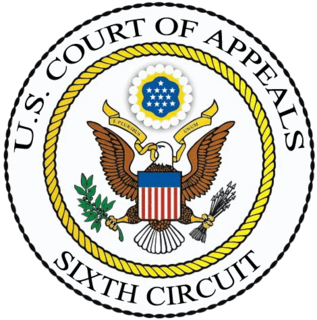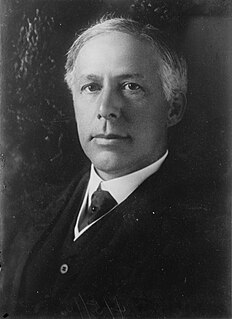Related Research Articles

The United States courts of appeals or circuit courts are the intermediate appellate courts of the United States federal judiciary. The courts are divided into 13 circuits, and each hears appeals from the district courts within its borders, or in some instances from other designated federal courts and administrative agencies. Appeals from the circuit courts are taken to the Supreme Court of the United States. The district, appellate, and Supreme courts are all authorized under Article Three of the United States Constitution, giving them the exclusive functions as constitutional courts.

The United States Court of Appeals for the Ninth Circuit is a federal court of appeals that has appellate jurisdiction over the district courts in the following districts:

The United States Court of Appeals for the Eighth Circuit is a United States federal court with appellate jurisdiction over the following United States district courts:

The United States Court of Appeals for the Second Circuit is one of the thirteen United States Courts of Appeals. Its territory comprises the states of Connecticut, New York, and Vermont. The court has appellate jurisdiction over the district courts in the following districts:

The United States Court of Appeals for the Third Circuit is a federal court with appellate jurisdiction over the district courts for the following districts:

The United States Court of Appeals for the Fifth Circuit is a federal court with appellate jurisdiction over the district courts in the following federal judicial districts:

The United States Court of Appeals for the Sixth Circuit is a federal court with appellate jurisdiction over the district courts in the following districts:

The United States Court of Appeals for the Seventh Circuit is the U.S. federal court with appellate jurisdiction over the courts in the following districts:
In the United States, the title of federal judge means a judge nominated by the president of the United States and confirmed by the United States Senate pursuant to the Appointments Clause in Article II of the United States Constitution.

The United States Court of Appeals for the Federal Circuit is a United States court of appeals headquartered in Washington, D.C. The court was created by Congress with passage of the Federal Courts Improvement Act of 1982, which merged the United States Court of Customs and Patent Appeals and the appellate division of the United States Court of Claims, making the judges of the former courts into circuit judges. The Federal Circuit is particularly known for its decisions on patent law, as it is the only appellate-level court other than the Supreme Court with the jurisdiction to hear patent case appeals.
The federal judiciary of the United States is one of the three branches of the federal government of the United States organized under the United States Constitution and laws of the federal government. Article III of the Constitution requires the establishment of a Supreme Court and permits the Congress to create other federal courts, and place limitations on their jurisdiction. Article III federal judges are appointed by the president with the consent of the Senate to serve until they resign, are impeached and convicted, retire, or die.
The Temporary Emergency Court of Appeals was established by the United States Congress in December 1971 with exclusive jurisdiction to hear appeals from the decisions of the U.S. district courts in cases arising under the wage and price control program of the Economic Stabilization Act of 1970.
Rapanos v. United States, 547 U.S. 715 (2006), was a United States Supreme Court case challenging federal jurisdiction to regulate isolated wetlands under the Clean Water Act. It was the first major environmental case heard by the newly appointed Chief Justice, John Roberts and Associate Justice, Samuel Alito. The Supreme Court heard the case on February 21, 2006 and issued a decision on June 19, 2006.

The United States District Court for the Eastern District of Missouri is a trial level federal district court based in St. Louis, Missouri, with jurisdiction over fifty counties in the eastern half of Missouri. The court is one of ninety-four district-level courts which make up the first tier of the U.S. federal judicial system. Judges of this court preside over civil and criminal trials on federal matters that originate within the borders of its jurisdiction. It is organized into three divisions, with court held in St. Louis, Hannibal, and Cape Girardeau.
The Court of Claims was a federal court that heard claims against the United States government. It was established in 1855, renamed in 1948 to the United States Court of Claims, and abolished in 1982. Then, its jurisdiction was assumed by the newly created United States Court of Appeals for the Federal Circuit and United States Claims Court, which was later renamed the Court of Federal Claims.
Yakus v. United States, 321 U.S. 414 (1944), was a decision by the United States Supreme Court which upheld congressional power to fetter judicial review and to delegate broad and flexible law-making power to an administrative agency in this constitutional challenge to the Emergency Price Control Act of 1942. The wartime anti-inflation measure, intended to expedite price control enforcement, conferred on the federal district courts jurisdiction over violations of Office of Price Administration (OPA) regulations made under the act. But judicial power to consider the constitutionality of such regulations was excepted. Congress specified that challenges to their validity be initially reviewed under stringent time limitations by the OPA and on appeal exclusively by a special Article III tribunal in the District of Columbia—the Emergency Court of Appeals—and thereafter by the Supreme Court.
United States v. Students Challenging Regulatory Agency Procedures (SCRAP), 412 U.S. 669 (1973), was a landmark decision of the United States Supreme Court in which the Court held that the members of SCRAP, five law students from the George Washington University Law School, had standing to sue under Article III of the Constitution to challenge a nationwide railroad freight rate increase approved by the Interstate Commerce Commission (ICC). SCRAP was the first full-court consideration of the American National Environmental Policy Act (NEPA). The Court also reversed the lower court decision that an injunction should be issued at the suspension stage of the ICC rate proceeding. The standing decision has retained its place as the high mark in the Court's standing jurisprudence.
The Government of Guam (GovGuam) is a presidential representative democratic system, whereby the President is the head of state and the Governor is head of government, and of a multi-party system. Guam is an organized, unincorporated territory of the United States with policy relations between Guam and the US under the jurisdiction of the Office of Insular Affairs.

Willis Van Devanter was an American lawyer who served as an Associate Justice of the Supreme Court of the United States from 1910 to 1937.

The Emergency Price Control Act of 1942 is a United States statute imposing an economic intervention as restrictive measures to control inflationary spiraling and pricing elasticity of goods and services while providing economic efficiency to support the United States national defense and security. The Act of Congress established the Office of Price Administration (OPA) as a federal independent agency being officially created by Franklin D. Roosevelt on April 11, 1941.
References
- ↑ Black's Law Dictionary, 7th ed. 1999
- ↑ Lockerty v. Philips, 319 U.S. 182 (1943).
- ↑ Harold M. Stephens, "The Chief Justice", 32 ABA Journal 387 (1946).
- ↑ Congressional Research Service. "Courts of Specialized Jurisdiction". Library of Congress . Retrieved 2009-09-25.
- ↑ "Emergency Court of Appeals: Judges". Federal Judicial Center.
![]() This article incorporates public domain material from websites or documents ofthe Congressional Research Service .
This article incorporates public domain material from websites or documents ofthe Congressional Research Service .